
Due to their
subterranean location the maturation of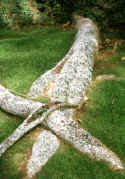 roots is literally out of
sight! However, due to erosion and violent atmospheric events like hurricanes we can gain
some insight into the extent of root systems when we view felled trees. When plants are
carefully studied it is found that their root systems are as large and complex as their
aerial systems. This is true for plants large and small. Some small desert plants have
enormous root systems that have far more biomass than their aerial
roots is literally out of
sight! However, due to erosion and violent atmospheric events like hurricanes we can gain
some insight into the extent of root systems when we view felled trees. When plants are
carefully studied it is found that their root systems are as large and complex as their
aerial systems. This is true for plants large and small. Some small desert plants have
enormous root systems that have far more biomass than their aerial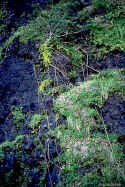 partners. It is not unusual for plants to have
a spreading root system close to the soil/air interface, as well as a deep root system
that is more vertical in its disposition.
partners. It is not unusual for plants to have
a spreading root system close to the soil/air interface, as well as a deep root system
that is more vertical in its disposition.
Water and minerals
are absorbed primarily in the root hair zone. Consequently, perennial plants have root
systems that are constantly spreading. The absorptive root tips are extremely fine. As one
progresses towards the base of the root, 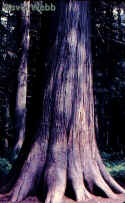 they are seen to become thicker and they
may have an obvious Periderm. Even the roots of herbaceous plants can have Secondary
Growth
they are seen to become thicker and they
may have an obvious Periderm. Even the roots of herbaceous plants can have Secondary
Growth
The Vascular Cambium is the source for secondary vascular tissues in roots as well as stems. Furthermore, Periderm is produced by Phellogen in the same way that we saw for stems. The major difference between stems and roots is the fact that stems have a Pith and roots in general do not!. The center of most roots is occupied by Primary Xylem. When Secondary Xylem forms it results in a continuous zone of xylem in the center of the axis. Woody species like Podocarpus, Pinus, Araucaria, Tilia, Quercus, Acacia koa & Hibiscus produce woody roots. Aside from the initial stages of development, Secondary Growth in Roots is virtually identical to what we have seen in stems. Consequently, it is a good idea to compare the two in this lab.

Dicot Roots

Ranunculus Mature Roots

Examine Commercial Slides of (Metaxylem) to reacquaint your self with a Mature Root that does NOT have Secondary Growth.
Note the Primary Xylem at the center of the axis

Alfalfa (Medicago sativa) Roots.

Observe commercial
slides of cross sections for  roots that show Secondary Growth.
roots that show Secondary Growth.
Try to locate the Primary Xylem.
Examine the cells present in the Secondary Xylem.
Is their evidence of Radial and Axial Systems in the Secondary Xylem?
If so how would you describe the Rays as seen in Transverse section?
Identify the cells which have stained positively for Lignin.
Are there other lignified cells in the Secondary Xylem?
Identify the various types of cells in the Secondary Xylem and roughly estimate their relative abundance. (i.e. 30%).
What does this suggest regarding the strength of the roots, or their ability to store carbohydrates?
Locate the Vascular Cambium and the Secondary Phloem.
If so are they lignified?
Is a periderm present?
If so, where did it originate?
Alfalfa sprouts!!! (If available examine the roots of Alfalfa seedlings and compare with those you just observed.

Castor Bean (Ricinis communis)

Examine Commercial slides and answer the same questions above in your mind.
Start with the large Green Cross sections (Castor Bean Root Older)
Then examine the
small blue Cross Sections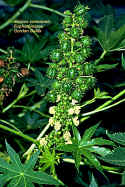 (Triarch).
(Triarch).
Compare and Contrast these two roots.
Why might these roots be dissimilar?
Which is most like Alfalfa?
Don't get hung up on this but try to make quick mental comparisons.
Examine fresh sections of Ricinis roots & stain with Toluidine Blue. Compare these with the commercial slides.
Examine fresh sections of other "Root Crops" like Carrot (Dacus carota).

Touchardia (Olona) Stems & Roots

Examine Cross Sections of Touchardia Stems & Stain with Toluidine Blue.
Locate the thick walled Laticifers in the Cortex of the stem. We did not observe these earlier when we looked at secretory structures.
Examine the Secondary Xylem and quickly review the questions asked above for Alfalfa Roots.
Examine Root Cross Sections and compare with the Touchardia stem.
How can you tell which is the stem and which is the root?

Tilia Roots

Examine Cross Sections of Tilia Stems which have Secondary Growth.
Be sure to examine the Xylem, Phloem, Cortex and Periderm!
Examine Cross sections of Roots with Secondary Growth and compare with the Stem. How similar are they!!! (1-10)??

Observe a Demo Slides of Radish (Raphanus). Does this help to explain why Radish is edible?

Gymnosperm Roots

Quickly examine
Commercial Stem Cross Sections of Pinus which have Secondary Growth.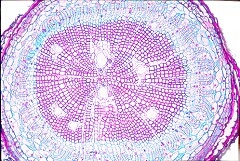
Examine Commercial DEMOS of Pinus & Podocarpus Roots which show Secondary Growth.
Compare with the Stem sections.
Observe fresh sections of Pinus, Podocarpus or Araucaria roots with Secondary Growth.
Stain with Toluidine Blue & compare with commercial slides.
What Generalization(s) can you make about the differences between Secondary growth in Angiosperms vs Gymnosperms?